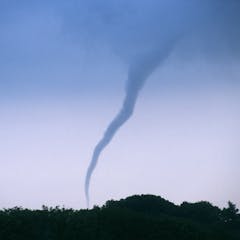
Articles on Storms
Displaying 1 - 20 of 130 articles

Extreme downpours and droughts, both fueled by rising global temperatures, are taking a toll on water infrastructure. Communities trying to manage the threats face three big challenges.

A new study shows how often lightning strikes and how it behaves, often hitting the ground with multiple strikes from the same flash.

Researchers tracked power outages after 8 major storms to see how wealth corresponded to recovery time.

These giant rivers in the sky are both destructive and essential for the Western U.S. water supply.

The impacts of record heat on the global water cycle were severe and wide-ranging – and the trend will continue in 2024.

An atmospheric scientist explains how rising temperatures are helping to fuel extreme storms, floods, droughts and devastating wildfires.

The US saw a record number of billion-dollar disasters in 2023, even when accounting for inflation. The number of long-running heat waves like the Southwest experienced is also rising.

Global climate models don’t let us zoom in on the fine details. A new set of high-resolution climate models for Australia is solving this problem.

Muttonbird ‘wrecks’ are becoming more common. Despite speculation about many possible causes, the evidence points to changes in the Arctic ocean ecosystem from where the birds migrate to Australia.

Storm Ciarán unleashed extremely strong and destructive winds in parts of the southern UK and northern France – here’s why.

Storms are the greatest threat to beach erosion, not sea level rise, research reveals. This is the longest continuous beach monitoring survey in the Southern Hemisphere.

More than 800 lives were lost in the Royal Charter storm but it also led to improvements in weather forecasting.

Britain doesn’t have huge violent twisters like the US. But it does have lots of little tornadoes.

Local communities need to be warned more clearly and effectively if there is a threat of a storm surge and of coastal flooding.

Climate assemblies may just provide the breakthrough required to develop popular, just and sustainable climate and energy policies.

Public interest in climate change and global warming peaks after bushfires and lasts for months, research reveals. But Australians do not respond to storms and floods in the same way.

A new study shows that river barriers, similar to those built by beavers, can protect areas at risk of flooding by storing water upstream.

2016 was the world’s warmest year on record, due in part to a very strong El Niño event. But 2023 (and 2024) could beat that record – what should we expect?

Nationally, 57% of the population says they’re not prepared for a flood disaster. Surveys and disasters show that those most at risk are least prepared.

Each rainbow is personal – the rainbow you see isn’t exactly the same rainbow the next person sees. It’s all in the eye of the beholder.
